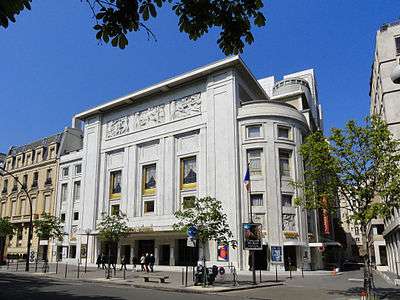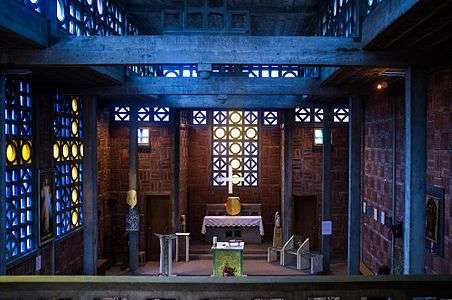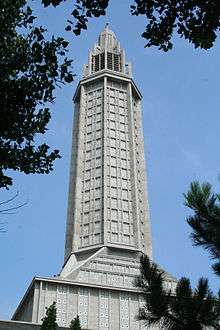Auguste Perret
| Auguste Perret | |
|---|---|
_(11872290045).jpg) Auguste Perret in 1921 | |
| Born |
October 6, 1874 Ixelles, Belgium |
| Died |
February 25, 1954 (aged 80) Paris, France |
| Nationality | French |
| Occupation | Architect |
| Awards | AIA Gold Medal (1952) |
| Buildings |
Théâtre des Champs-Élysées St. Joseph's Church, Le Havre French Economic, Social and Environmental Council Église Notre-Dame du Raincy |
Auguste Perret (12 February 1874 – 25 February 1954) was a French architect and entrepreneur who worked in collaboration with his two younger brothers, Claude and Gustave Perret. He was one of the pioneers of the architectural use of reinforced concrete, and built the first residential buildings with that material. His other major works included the Théatre des Champs-Élysées, the first Art Deco building in Paris. His other important works include the The Church of Notre-Dame du Raincy (1922–23); the Mobilier Nationale in Paris (1937); and the French Economic, Social and Environmental Council building in Paris (1937–39). After World War II he designed a group of buildings in the center of the port city of Le Havre, which had been almost entirely destroyed during the war. In 2005, his post-World War II reconstruction of that city was declared by UNESCO a World Heritage Site.
Early life and work (1903-1930)
Auguste Perret was born in Ixelles, Belgium, where his father, a stone mason, had taken refuge after the Paris Commune. He received his early education in architecture in the family firm. He was accepted in the architecture course of the École des Beaux-Arts in Paris, along with his two brothers, Gustave (1876-1952) and Claude (1880-1960). where he studied under Julien Guadet, a Beaux Arts neoclassicist who had collaborated with Charles Garnier on the construction of the Paris Opera. Beyond the neoclassical rationalism he learned from Gaudet, Perret's particular interest was the structure of buildings and the use of new materials, such as concrete. Though he was considered a brilliant student, he left School without obtaining a diploma and went to work for the family firm. [1]
Perret immediately began experimenting with concrete. His first important project was an apartment building on rue Franklin in Paris (1903), where the concrete structure, instead of being concealed, was clearly visible and was a part of the exterior design. He made an even more radical experiment with the construction of a garage on rue de Ponthieu (1906) (now destroyed) with a simplified cubic structure expressing the interior, large bays of windows and a lack of decoration, which resembled the later International Style.[2]
-
.jpg)
Reinforced concrete apartment building at 25 rue Benjamin Franklin, Paris (1903)
-

Théâtre des Champs-Élysées, Paris (1913)
-

Interior of the Théâtre des Champs-Élysées (1913)
-

Interior of the Church of Notre Dame du Raincy (1922-23)
-

Cortot Hall concert hall of the École Normale de Musique de Paris in Paris. (1929)
Major works (1913-1939)
His most famous building was the Théâtre des Champs-Élysées a project which he took over from the Art Nouveau architect Henry van de Velde. The facade was simple and decorated only with a sculptural bas-relief by Antoine Bourdelle. The corner of the building was smooth and rounded, anticipating the Streamline Moderne style three decades later. Thanks to the use of concrete pillars, the interior lobby and the theater itself was vast and open, unobstructed by columns. The interior decoration featured works by the modernist artists of the day; a dome by Maurice Denis, paintings by Édouard Vuillard and Jacqueline Marval, and a stage curtain by Ker-Xavier Roussel.[3]
In his later works, Perret used concrete in imaginative ways to achieve the functions of his buildings, while preserving classical harmony , symmetry and proportions. His major works included the building of the French Economic, Social and Environmental Council, originally built for the Museum of Public Works of the 1937 Paris Exposition; and the Mobilier Nationale de Saclay, the national government furniture depot in Paris. warehouse. He also created innovative industrial buildings, including a warehouse in Casablanca covered with a think veil of concrete (1915) and an extraordinary concrete church, Notre Dame du Raincy (1922-23), where the interior columns were left undecorated and the concrete vaults of the ceiling became the most prominent decorative feature. He experimented with concrete forms to achieve the best acoustics for the concert hall of the École Normale de Musique de Paris in Paris. (1929)[4]
Later works (1930-1954)
-

The Chapel of Immaculate Conception in Arcueil (1930)
-
_(11872278295).jpg)
Grand stairway of the Conseil économique, social et environnemental, Paris (1937) now decorated with a portrait of Perret
-
The Saclay Nuclear Research Centre (CEA) in Saclay, in the Paris suburb of Essone (1952)
-

Spire of St. Joseph's Church, Le Havre (1951-58)
Postwar works (1945-54)
In 1952 he completed construction of the Saclay Nuclear Research Centre in the Paris suburb of Essonne. He described this building as a "Small Versailles for nuclear research". Most of France's early nuclear reactors were constructed within the site.
His other major postwar projects were the reconstruction of the center of the port of Le Havre, which had been almost totally destroyed during the war. His first plan was rejected as too ambitious, but his modified plans were followed and were later listed as a UNESCO World Heritage Site. His last major work, finished after his death, was the St. Joseph's Church, Le Havre, (1951–58) whose most prominent feature is its tower, like a lighthouse, 107 meters high, and visible at sea. He also participated in the postwar reconstruction of the port of Marseille and Amiens.[5]
Prominent students and later life
Among the many young architects who worked in the bureau of Perret from 1908 to 1910 was Charles-Édouard Jeanneret-Gris, who later became known as Le Corbusier; it was his first experience in an architectural office.
From 1940 Perret taught at the École des Beaux-Arts. He won the Royal Gold Medal in 1948 and the AIA Gold Medal in 1952.
Perret also served as a juror with Florence Meyer Blumenthal in awarding the Prix Blumenthal, a grant given between 1919 and 1954 to young French painters, sculptors, decorators, engravers, writers, and musicians.[6]
Work
- Rue Franklin apartments, Paris, 1902–1904
- Garage Ponthieu, Paris, 1907
- Théâtre des Champs-Élysées, Paris, 1913
- Concrete cathedral in Le Raincy, France, Église Notre-Dame du Raincy, 1923, with stained-glass work by Marguerite Huré
- Concert hall of the École Normale de Musique de Paris, 1929
- Hôtel Saint-Georges, Beirut, Lebanon 1932[7][8]
- Immeuble Lange, 9 place de la Porte-de-Passy, Paris (1929-1932)
- Services Techniques des Constructions Navales, 8 boulevard du General-Martial-Valin (15th arron.) Paris, 1929-1932; an example of a framework of exposed concrete columns.
- Building, 51-55 rue Raynouard (16th arr.) Paris, (1932), where Perret had his offices
- Palais Ién], Paris, 1937, originally built as the Museum of Public Works for the 1937 Paris Exposition, now home of the French Economic, Social and Environmental Concil
- Extensions to the École nationale supérieure des Beaux-Arts, Paris, 1945
- City Hall, St. Joseph's Church and further reconstruction of the French city of Le Havre after more than 80,000 inhabitants of that city were left homeless following World War II, 1949–1956
- Gare d'Amiens, 1955
- Villa Aghion, in Alexandria (partial attempt to destroy, 28 August 2009. Destroyed completely by January 21, 2016)
- Tour Perret, Grenoble
See also
References
Notes and Citations
- ↑ Petit Robert Dictionnaire Universel des Noms Propres (1988)
- ↑ Petit Robert Dictionnaire Universel des Noms Propres (1988)
- ↑ Petit Robert Dictionnaire Universel des Noms Propres (1988)
- ↑ Petit Robert Dictionnaire Universel des Noms Propres (1988)
- ↑ Poisson 2009, pp. 299-301.
- ↑ "Florence Meyer Blumenthal". Jewish Women's Archive, Michele Siegel.
- ↑ "Hôtels mythiques, hôtels de guerre: Beyrouth, nager dans les ruines". Obsession. 2014. Retrieved August 23, 2014.
- ↑ A Global History of Architecture by Francis D. K. Ching, Mark M. Jarzombek, Vikramaditya Prakash page 712
Bibliography
- Fierro, Alfred (1996). Histoire et dictionnaire de Paris. Robert Laffont. ISBN 2-221-07862-4.}
- Lemoine, Bertrand (2000). Guide d'architecture - France 20th century. Picard.
- Poisson, Michel (2009). 1000 Immeubles et monuments de Paris. Parigramme. ISBN 978-2-84096-539-8.
- Renault, Christophe (2006). Les Styles de l'architecture et du mobilier. Editions Jean-Paul Gisserot. ISBN 978-2-877474-658.}
- Texier, Simon (2012). Paris- Panorama de l'architecture. Parigramme. ISBN 978-2-84096-667-8.
External links
| Wikimedia Commons has media related to Auguste Perret. |
- Flickr Pool with pictures
- List of realisations on Archiguide
- Auguste Perret on GreatBuildings.com
- Garage Ponthieu at Scholars Resource
- Auguste Perret at Find a Grave